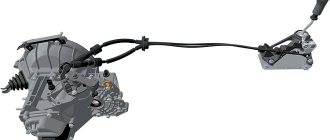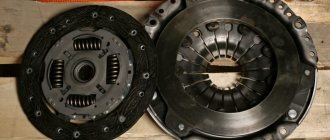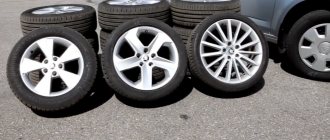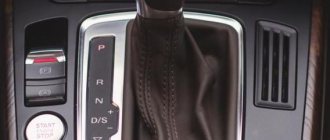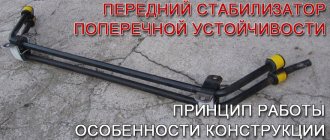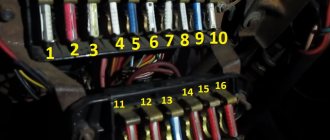In mid-2016, AvtoVAZ officially abandoned the use of manual transmissions from the French manufacturer Renault. The reason is the high cost of the “product” and the lack of a base for maintenance.
If domestic gearboxes cost 20–25 thousand rubles, then imported ones reached 45–50 thousand. Obviously, such a rise in price automatically increased the cost of the car as a whole. Perhaps because of this factor, many car enthusiasts preferred a model with a classic automatic or robotic option.
However, there are those who claim that the quality of production of domestic new mechanics (21087) is inadequate. They are ready to pay an additional 30,000 rubles for the French version. Let's compare the Renault JH3 (JR5) manual transmission and the VAZ 21087 manual transmission.
Specifications
| Name | Renault JH3 (JR5) | Manual transmission - 21087 |
| type of drive | Wire rope | |
| Number of speeds | 5 | |
| Main couple | 3,9 | |
| Gear ratio | 3,87 | 3,94 |
| Acceleration to “hundreds” | 11,2 | 10,2 |
| Maximum speed (km/h) | 175 | 188 |
| Fuel consumption (l/100 km) | 6,9 | 7,5 |
| Gear ratios for each gear | 3,636; 1,950; 1,357; 0,941; 0,784 | 3,727; 2,048; 1,393; 1,029; 0,795 |
Installing a shorter main pair increased the dynamics of acceleration, taking one second from the French “brand”. Adjusting the gear ratios for each gear made the transitions to higher gears smoother, without jerking, and dynamic.
What kind of gearbox does the Lada Vesta have (manual)
Initially, the Lada had AvtoVAZ gearboxes. But driving with them was not very comfortable due to the strong rumble they made. In order to “keep the brand” and not spoil the image of the domestic auto industry, manufacturers decided to replace the native mechanics with French ones - Renault JH3. The cost of these units is much higher than those of AvtoVAZ, and repairs are more expensive due to imported spare parts.
Replacing a Renault JH3 gearbox with a VAZ-21807 gearbox
It was the unfavorable price of the Renault box that forced the plant to reconsider the issue of the Lada Vesta configuration. Nowadays, domestic cars are equipped with VAZ-21807 “mechanics”. This is an improved version of the VAZ-2180 box. The new gearbox has the following advantages:
- designed for increased torque;
- does not make noise like the first version of the VAZ-2180 gearbox;
- more hardy;
- Spare parts for repairing a Lada Vesta VAZ-21807 manual transmission cost less than for a Renault transmission.
- after re-equipment, the acceleration time of the car decreased;
- The maximum speed has increased.
But there are also negative aspects. Fuel consumption increased from 6.9 to 7.5 liters per 100 km in urban mode. The price of these cars has not decreased, although initially the manual transmission was replaced precisely for this purpose. In addition to Vesta, Priors, Grants, and Kalinas are equipped with such boxes.
What do we have today - manual transmission Renault JH3 or VAZ-21807?
Since the end of 2016, all Vestas have been produced with VAZ mechanics. Naturally, car enthusiasts today own cars with both French and domestic mechanics. The gear shift lever remains the same. Therefore, you will not be able to determine the model based on the interior configuration of the box. It is easy to understand which version of the gearbox is in the car by the VIN number. If the code is GFL 13, then it is a Renault gearbox, and if the number is GFL 11, then it is an AvtoVAZ manual.
Design and diagram of manual transmission on Lada Vesta
| Name | Data |
| Type | Mechanics |
| Factory index (article) | 21087 |
| Drive unit | Front |
| Engine capacity | 1,8 |
| Torque | 170 Nm |
| Default oil type | ZIC GFT 75W-85 |
| Oil volume | 2,2 |
| Lubricant replacement | Every 75,000 km |
| Filter update | Likewise |
| Average service life before major overhaul | 180000 km |
| Compatibility | Lada Vesta, X-RAY with engine capacity 1.6 / 106 hp., 1.8 / 122 hp. |
Related link:
Side mirrors of Lada Vesta.
Checkpoint operation diagram
To find out the transmission type of your car, look at the VIN code:
- GFL11: mechanics;
- GFL12 - AMT box;
- GFL13 ─ mechanics from Renault.
Changing the oil in manual transmission Lada Vesta
On a modern manual Lada Vesta, it is recommended to change the oil every 75 thousand kilometers. However, when the driver drives little, this operation is carried out once every five years. Do not forget that these data relate to normal driving modes.
If the vehicle is operated in conditions close to extreme or with increased load on the gearbox, the oil is changed more often. Typically, the oil is changed based on mileage or after a visual assessment of the condition of the oil and its level in the gearbox. 2.2 liters of oil are poured into the Lada Vesta box.
“Pros” and “cons” in comparison with an automatic machine (robot)
| Advantages | Flaws |
| Acceleration dynamics have become better, the car picks up speed faster | Increased fuel consumption in the combined cycle |
| The car is 30 - 35 thousand cheaper when purchased with a manual transmission | Crunching, creaking when driving at low speeds |
| Long service life | |
| Cheapness of spare parts and components | |
| The car is more expensive on the secondary market compared to the robotic version | |
Variable speed drive
And, of course, fans of the Tolyatti auto industry are looking forward to the appearance of the promised CVT in 2022. According to preliminary information, a variator with an imitation of 7 steps will first be offered in combination with the Nissan 1.6L HR16 engine, since we are talking about the Jatco JF015E transmission, which is designed for torque up to 160 Nm. It is quite possible that in the future the CVT continuously variable transmission will be gradually adapted to its own 1.8L engine.
The advantages of a CVT over an AMT are obvious. This is, first of all, the convenience of speed control. Cars with CVT pick up speed especially smoothly, without jerks or dips. They have a smoother ride and more dynamic acceleration than AT cars. The CVT is significantly quieter and more economical than classic torque converter transmissions.
Malfunctions and ways to eliminate them
| Malfunctions | Troubleshooting Methods |
| Transmission howl at 2000 – 3000 rpm | Insulation lining for gearbox control cables |
| Knock at idle | Replacing the pressure bearing |
| Critical wear of gears and teeth | Replacement with new ones, cannot be restored |
| Oil leaks from seals are less common. | Replacement of sealing seals with new ones. Overhaul of gearbox |
Causes of malfunctions and repair of Lada Vesta manual transmission
The listed signs of gearbox defects may appear for various reasons. They can only be identified through diagnostics. By the way, the correct diagnosis for a car is no less important than for a person. After all, the Lada Vesta manual transmission repair plan is developed precisely for reasons, and not for symptoms. We will give the most common root causes of breakdowns and indicate a possible way to solve the problems. We say “possible” because to accurately determine the progress of work we must see the car.
Why is there noise in the manual transmission of Lada Vesta?
- One of the reasons that the gearbox has become noisy is the wear of the release bearing. To fix the problem, we will replace the faulty part with a new one.
- Excessive noise often occurs when the gears are heavily worn. In this case, you will need to replace the damaged parts.
- Noise in the gearbox can be caused by a reduced level of transmission fluid. To solve the problem, we will add oil to the box.
Why don't the gears engage or are difficult to engage?
- This may be due to the clutch not disengaging. Diagnosis, repair, and possibly clutch replacement will be required.
- This defect may also indicate that the gear shift drive in the car is incorrectly adjusted. Come over, our technicians will adjust the drive, and the difficulties in switching will disappear.
- In addition, plastic parts in the transmission control drive could break. To eliminate the problem you will have to replace them.
Why do the Lada Vesta gearbox switch off?
- Firstly, spontaneous gear disengagement can occur due to severe wear of the synchronizer. We fix the problem by replacing parts.
- Secondly, this breakdown may be a consequence of faulty supports. To restore normal operation of the box you will need to replace them.
- Thirdly, the reason may be that the gears are not fully engaged. Diagnostics and proper adjustment of the drive will be required.
Why is oil leaking from the VAZ-21807 gearbox?
- A leak starts if the housing parts are worn out. These include oil seals, rods, and hinges. What are we doing? We replace worn elements.
- Leaks can also occur if the housing is depressurized or the cover or crankcase is loosened. In this case, we will replace the gasket or “seat” it with sealant.
Service life - from the factory and actual
The manufacturer in the operating instructions indicates an average interval of 180,000 km before major repairs. In fact, the mechanics last up to 200,000 km, provided that the manufacturer’s recommendations for care and maintenance are followed.
At the stage of using mechanics, breakdowns associated with depressurization of the system, oil leakage, and wear of the pressure bearing are most often recorded. Malfunctions are insignificant, not critical, and can be eliminated in a few hours of work by technicians at a service station.
Conclusion
The manual transmission under the factory code 21087 is a real technological breakthrough of domestic engineers. The transmission turned out to be not only more powerful, but also faster. At the same time, fuel consumption increased by 0.5 liters.
“Mechanics” has its advantages and disadvantages compared to the robotic version. Therefore, before purchasing, carefully analyze the technical characteristics of each type of gearbox.
Related link:
Specifics of the dashboard firmware on the Lada Vesta.
From personal experience I will say the following:
- The mechanics are most adapted for active use on rough terrain.
- The robotic version, “automatic”, is mainly used for high-speed modes.
Gearbox AMT 2182
AMT (automated manual transmission) is a development of a Russian manufacturer that is worthy of attention. The box is controlled by an electromechanical drive, which is perfectly suited to domestic climatic conditions. Unlike hydraulic analogues, the box does not “freeze” in winter and does not require warming up before driving. The electronics cope perfectly with all the commands of the control unit, relieving the driver of tasks such as pressing the clutch pedal and changing gears. The only drawback of AMT can be considered slow gear shifting, which is clearly not suitable for those who like to “put pressure to the floor.”
In the production of the AMT 2182 gearbox, the VAZ-2180 manual transmission was taken as a basis. The box was equipped with a primary shaft rotation speed sensor and a gear shift control system from the German company ZF.
The designation GFL12 in the VIN code indicates that a “robot” is installed on the car.
Thanks for subscribing!
Reviews
| № | Positive |
| 1. | Dmitry , 33 years old (drive2.ru): they can’t say anything bad about the mechanics, the gearbox works properly. The car is only a year old, I regularly undergo maintenance, I don’t drive, I drive carefully. |
| 2. | Vyacheslav Petrovich , 47 years old (prom.ua): in a year and a half I drove about 20,000 km, mileage is above average. Impressions of the new mechanics are only positive. There is something to compare with; before this there was the Lada Granta. Grantmakers understand what I'm talking about. |
| 3. | Alexander Alekseevich , 43 years old (drom.ru): after buying the car, I changed the transmission oil for the first time at the 7000 km mark. I didn’t wait for 75,000 km, as the manufacturer recommends. The waste was of a natural color, metal shavings were present, but their quantity was insignificant. I did the same. |
| 4. | Alexey Petrovich , 48 years old (rozetka.ua): I’ve heard numerous negative reviews about the mechanics, I can’t confirm. I believe that the technical condition and performance of the unit depends on the driver. I don’t have any problems with this, I take care of my equipment. |
| 5. | Semyon Vyacheslavovich , 40 years old (Auto.ru): This is the second year since I bought and actively use a Lada Vesta on the mechanics. The review is positive, there are no comments about the work. |
| 6. | Vasily Timofeevich , 43 years old (Auto.Mail.Ru): for a year and a half of using a car with mechanics, he once made an unscheduled visit to a service station for diagnostics. I was at fault for the hum in the manual transmission, but it was the suspension. I hope that the device reaches the 180,000 km specified by the manufacturer. |
| 7. | Dmitry Gennadievich , 41 years old (drive2.ru): I like the mechanics more than the robot, I drove the AMT for three months, I can compare. Both robot and automatic are not adapted for domestic roads. The units do not last long, so it is better to buy a manual transmission. |
| 8. | Sergey , 35 years old (drive2.ru): on the mechanics, as soon as I pressed the pedal, I pressed it. And overtaking, and maneuverability, without kickdowns, delays in switching. Choice: definitely mechanics. |
| Negative | |
| 9. | Dmitry Semenovich , 52 years old (prom.ua): no matter how hard we tried, a miracle did not work. We decided to save several tens of thousands, but for the wrong reasons. It would be better to make the plastic cheaper than to install a Russian gearbox instead of a French one. Knocking and noise in the manual transmission was detected at 40,000 km. With such a low mileage there are such significant defects. |
| 10. | Gennady , 46 years old (Bibika.ru): after 30,000 km, cases of clutch slipping, delays when changing to higher gears, and howling of the gearbox became more frequent. You need to go to a workshop and order diagnostics. Couldn’t it have been done better from the start? |
| 11. | Boris , 38 years old (drive2.ru): at 25,000 km a gearbox whine appeared on a Lada Vesta. The officials said that the pressure bearing needs to be changed, but this is not certain. The final diagnosis will be announced after a comprehensive diagnosis. |
| 12. | Sergey Gennadievich , 45 years old (Avtodispatcher.ru): a knock in the gearbox was detected already at 31,000 km. Initially the fault was with the suspension, but after diagnostics the technician assured me otherwise. |
Related link:
Ambient temperature sensor Lada Vesta.
Robot AMT
The third option is the simplest and most affordable two-pedal automatic transmission option. AvtoVAZ tried for a long time to create its own automatic machine. But there was no experience and developments in this direction. Therefore, they turned to foreign specialists from the German company ZF for help.
The result of this collaboration was the famous VAZ robot. Structurally, it is the same 5-speed manual transmission of the VAZ-2180, to which, during the modernization process, 2 actuators were added that do all the work for you: clutch and gear shift actuators.
This transmission has the VAZ-21827 index. The first robot was installed on the Lada Priora in 2014. Then it was installed on Grant. Subsequently, he reached Vesta and X-Ray. At the time of review, the robot is only available for the Lada Granta.
The first versions of the robot had an index of 21826, and there, in order for the car to start moving in “drive” mode, you had to press the gas pedal. I think this is not very convenient for an automatic transmission. Later we made a new firmware and added a “crawling” mode. That is, the car in “drive” mode began to move automatically after releasing the brake pedal. The box index became 21827.
The good thing about the robot is that it is not particularly demanding. It does not have special operating conditions that must be strictly observed in order for the unit to serve for a long time and without problems. If you compare it with a CVT, which has many “buts” and “don’ts,” then with a robot everything is really simple. It does not need to be warmed up before driving, it can be skidded, it is allowed to be towed. Dynamic driving is allowed. The oil change procedure costs only 2,500 rubles. That is, of all automatic transmissions, the robot is the simplest, most affordable and unpretentious transmission.
Pros and cons of the robot
Since it is the same VAZ 5-speed manual, it will be just as reliable, unpretentious, maintainable and inexpensive to maintain and repair. Actuators are expensive, but there are no problems with them in operation. Unless the clutch actuator with high mileage may begin to squeak. But this can be solved easily and quickly by removing, disassembling and lubricating.
Of the minuses, there were several nuances. Firstly, there were problems with the clutch discs. This manifested itself in the form of increased vibration of the transmission at the beginning of movement. The clutch disc manufacturer has modernized them several times and changed the composite composition of the friction linings. But this problem could not be completely solved.
The second negative point of the robot is that when driving in traffic jams, when there is frequent starting, the transmission may overheat. The box will go into emergency mode and the car will stop moving. It will take some time for the mechanism to cool down. Otherwise there were no problems.
Gearbox for Vesta: “pull” the handle or enjoy the robot?
An important event at the end of 2015 in the Russian automobile industry was the start of sales of the Lada Vesta car. The car boasted a stylish design and good technical solutions.
Thus, AvtoVAZ installs three types of gearbox on the new product: classic mechanics, a robot that has proven itself in other models, and an innovative variator, abandoning the use of automatic transmission.
All these options have both their advantages and disadvantages, so there is no clear solution to the question of which gearbox is better and whether it was worth giving up the automatic. To choose the optimal car configuration for yourself, you should learn more about the gearboxes offered.
Foreign technologies in a Russian car
During the design process, it was planned to equip the Vesta with a Russian-made manual transmission, but AvtoVAZ specialists were unable to get rid of the presence of noise in some stages. It was decided to use JH mechanics from the partner concern Renault-Nissan.
The JH installed gearbox is used on many foreign car models. It has proven itself to be a silent, high-quality manual transmission.
The shift mechanics themselves moved to the upper zone of the transmission, which reduced oil consumption for operating a manual transmission and eliminated the defect of difficult gear changes caused in this mechanics by thickening the oil at low temperatures.
The only drawback of introducing a foreign gearbox was the price of the manual, which for this gearbox is twenty percent higher than for its domestic counterpart.
The manual transmission on Vesta is installed in conjunction with two Russian engines VAZ 21116 and VAZ 21127.
Intelligent technologies of Russian production
The second transmission option for the new car was a domestically developed robotic gearbox (AMT). This type of automatic transmission began to be used abroad ten years ago, but did not gain popularity, as it had a number of serious shortcomings, and manufacturers switched to using conventional automatic transmissions, CVTs and standard mechanics.
Taking into account foreign experience, AvtoVAZ specialists developed their own robotic five-speed gearbox based on the VAZ 2180 gearbox. This robot uses actuators from the German company ZF and a clutch from VALEO Corporation.
The AMT from AvtoVAZ has a built-in wear compensation system for the clutch; in addition, it does not require warming up before driving, like a conventional automatic transmission. Gear shifting is allowed in automatic and manual mode.
It weighs significantly less than a machine gun, which reduces the fuel consumption of the Lada Vesta.
An important parameter of AMT is the simplicity and low cost of repairs, comparable in cost to repairing a conventional manual transmission and, of course, much cheaper than restoring an automatic transmission.
The main advantage of the AMT over the automatic transmissions used on other Lada models, which decided the feasibility of its use even at the gearbox design stage, is considered to be the price, which is 20 thousand rubles. For comparison, a JATCO automatic transmission costs owners 40 thousand rubles.
The only drawback of the robot from AvtoVAZ is the need to fix the position of the car with the hand brake or gas pedal when parking downhill, because the car may start to roll back.
But this minus pales in comparison to the many advantages of AMT, of which it is also worth mentioning protection against incorrect gear selection; the possibility of acceleration no less sharp than with a manual transmission; low fuel consumption; the working volume of oil is three times smaller compared to an automatic machine. And also when the car is moving, the gearshift lever does not vibrate; The clutch closes smoothly, even with sudden addition of gas.
This is not the first time that a robotic gearbox has been used on a Lada; AMT was used on Grants and Kalinas and completely replaced an automatic transmission with them.
The results of recent surveys of owners of cars with AMT indicate that there are no complaints about this gearbox.
Moreover, the Renault concern has plans to introduce this Russian gearbox on its models, instead of an automatic transmission, which indicates quality better than any loud statements.
The AMT is installed in tandem with two of the three engines used in the Lada Vesta: VAZ 21129 and HR16DE-H4M.
CVT from partners
More recently, information has become known about AvtoVAZ’s decision to install on the Lada Vesta, in addition to robots and mechanics, a variator, which will most likely be provided by the Renault-Nissan alliance, since AvtoVAZ has no developments in this area.
Let us remind you that the CVT is an automatic transmission without fixed steps, which ensures smooth acceleration of the car, in addition, fuel consumption with it is less than with an automatic transmission installed.
The disadvantages of a CVT include more expensive maintenance and repairs than when using manual and automatic transmissions.
We will have to wait quite a long time for the release of the new product, since the engine from Renault-Nissan, in tandem with which the variator will work, is not yet installed on production Lada Vesta cars, and owners of cars of this series will have time to first evaluate the robot and mechanics for comparison with a CVT, which is rare for the domestic auto industry.
Thus, AvtoVAZ managers decided to implement many different technological solutions in equipping the new car with a gearbox in order to take into account the needs of all motorists interested in purchasing domestic cars.
Source: https://VestaTeam.ru/kpp/kpp-dlya-vesty.html
| Depending on the configuration, the car is equipped with five-speed JH3 and JR5 gearboxes, made according to a two-shaft design with synchronizers for all forward gears and combined with a differential and final drive. Transmission fluid is poured into the gearbox at the factory, which is designed for the entire service life of the vehicle. Therefore, there is no need to change the gearbox oil according to maintenance schedules. Gearbox JH3 Gearbox JH3: 1 — rear gearbox cover; 2 — clutch cable bracket; 3 — clutch fork; 4 — gearbox housing; 5 — breather fitting; 6 — gear shift mechanism; 7 — cavity for the speed sensor; 8 — shaft of the right side differential gear; 9 — clutch housing; 10 - input shaft; 11 — boot; 12 — holder for electrical wires; 13 — oil filler cap; 14 — housing of the internal hinge of the drive mechanism of the left wheel; 15 - reverse light switch The car engine, like all internal combustion engines, develops power and torque in a relatively narrow speed range. As engine speed decreases, power decreases
When driving a car, it becomes necessary to use different speeds and different traction forces. For example, when driving through deep sand, the speed is insignificant, and a fairly large traction force is required to overcome the resistance of the road. Great traction force is also required when starting the car and overcoming steep inclines. On the contrary, when driving on a paved road, little traction is required, but the speed of movement can be high.
Due to the fact that the engines of different car models have different power, then, of course, the gear ratios of individual gears, and, consequently, the number of teeth of the gears are different. However, the operating principle of the gearboxes is the same, and the disassembly, assembly and repair operations are generally similar. The purpose of the gearbox is to ensure further conversion of torque in magnitude and direction in accordance with the load on the vehicle, as well as to enable the engine to idle. The basic principle of operation of the gearbox is the same everywhere, the essence of which is the pairwise connection of gears that have a different number of teeth. In this case, the torque transmitted by the gears changes in proportion to the gear ratio, i.e. The ratio of the number of teeth on the driven gear to the number of teeth on the drive gear. A gearbox is, in principle, a very simple device. Gearbox control mechanism: 1 – bushing (the gearbox control rod is connected to it); 2 – gearbox lever retainer; 3 – gear shift lever (has a ball bearing that is inserted into the body); 4 – lever handle; 5 – plastic body Gearbox control rod: 1 – coupling bolt; 2 – clamp; 3 – nut; 4 – traction; 5 – traction finger The rod is attached at one end to the bushing of the gearbox control mechanism, and at the other end to the shift mechanism installed on the gearbox. |
Possible gearbox options
The new Lada X ray uses modern gearboxes, the development of which was carried out specifically for this model. The presented gearboxes are the next step for AvtoVAZ cars. They deservedly receive positive reviews from motorists who have experienced them in action.
For xRay, there are three gearbox options, two of which were developed by the French, and the third by AvtoVAZ itself.
The first two options have a five-speed manual gearbox, and the domestic gearbox has a robotic automatic transmission.
The domestic AMT transmission quickly proved itself to be the most reliable and high-quality among this type of gearbox. When using it, the driver can quickly switch between manual and automatic modes.
Gearboxes are divided into the following options:
- Manual transmission JR5 518 – French 5-speed, using multi-cone synchronizer;
- Manual transmission JH3 512 – French 5-speed gearbox;
- robot VAZ-21827 - AvtoVAZ robotic box.
Mechanics in lada xRay
The X Ree manual transmission is divided into two options: JR5518 and JR3512. Although they both have 5 gear stages, they differ in shift clarity and reliability of the transmission as a whole.
Unlike the old gearboxes used by the manufacturer, the new ones are significantly quieter and vibrate less.
The shift lever moves smoothly and easily, which reduces the effort required while driving.
In addition, the new boxes use much less oil, thanks to the shifting mechanism being moved to the upper sphere. These changes have led to a reduction in the likelihood of difficulty shifting gears in subzero temperatures, as well as a complete disappearance of the problem with oil thickening and freezing.
The gear shift module for x rays, which is responsible for smooth shifting, was produced in Germany. The noiselessness and strength of the box is ensured by the secondary shaft and new synchronizers.
Robotic gearbox in xRay
For strategic reasons, AvtoVAZ decided to replace the conventional automatic transmission with a robotic gearbox. Initially, this gearbox was not accepted by motorists, but after some time it was able to gain an excellent reputation, showing its advantages in practice. It was able to outperform its foreign counterparts in terms of quality.
The robotic gearbox has built-in electrical components that compensate for the clutch. The clutch itself was made by Valeo, and the actuators come from Germany.
The box contains protection that prevents incorrect switching. The gearbox has low fuel and oil consumption. It offers both manual and automatic modes, as well as a gear reset mode.
Gear changes occur quickly and without jerking.
The automatic transmission in xRay is able to independently adapt to the owner’s driving style and does not require warming up even in severe frosts. In general, owner reviews are positive, but there are also questions about its operation. For example, the need to fix the gas pedal or when stopping is not camping. In some cases, there may be slight jerking of the gearbox.
Watch the video test drive with the AMT gearbox from Lisa:
Source: https://ixray.ru/reviews/172-korobka-peredach-xray
